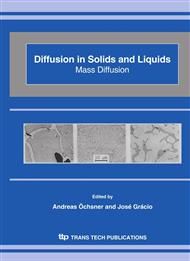[1]
R. Giangiacomo, D. Torreggiani and E. Abbo: J. Food Process. Preserv. Vol. 11 (1987), p.183.
Google Scholar
[2]
P.P. Lewicki and A. Lenart: In Handbook of Industrial drying, Vol. I (2nd Ed. ) (p.691). (Marcel Dekker Inc., New York, 1995).
Google Scholar
[3]
B. Gerelt, Y. Ikeuchi, and A. Suzuki: Meat Sci. Vol. 56 (2000), p.311.
Google Scholar
[4]
O. Corzo and N. Bracho: J. Food Eng. Vol. 66 (2005), p.51.
Google Scholar
[5]
J. Hawkes and J.M. Flink: J. Food Process. Preserv. Vol. 2 (1978), p.265.
Google Scholar
[6]
M.H. Kim and R.T. Toledo: J. Food Sci. Vol. 52 (1987), p.980.
Google Scholar
[7]
I.G. Mandala, E.F. Anagnostaras and C.K. Oikonomou: J. Food Eng. Vol. 69 (2005), p.307.
Google Scholar
[8]
G.M. Dixon, and J.J. Jen: J. Food Sci. Vol. 42 (1977), p.1126.
Google Scholar
[9]
F. Prothon, L.M. Ahrné, T. Funebo, S. Kidman, M. Langton and I. Sjöholm: Lebens. Wissens. Technol. Vol. 34 (2001), p.95.
DOI: 10.1006/fstl.2000.0745
Google Scholar
[10]
H.R. Bolin, C.C. Huxsoll and R. Jackson: J. Food Sci. Vol. 48 (1983), p.202.
Google Scholar
[11]
A.L. Raoult-Wack: Trends Food Sci. Technol. Vol. 5 (1994), p.255.
Google Scholar
[12]
A. Chiralt, N. Martínez-Navarrete, J. Martínez-Monzó, P. Talens, G. Moraga, A. Ayala and P. Fito: J. Food Eng. Vol. 49 (2001), p.129.
DOI: 10.1016/s0260-8774(00)00203-x
Google Scholar
[13]
N.B. Tregunno and H.D. Goff: Food Res. Int. Vol. 29 (1996), p.471.
Google Scholar
[14]
W.E.L. Spiess and D. Behsnilian: Proceedings IDS '98, Vol. A (1998), p.47. Haldiki, Greece.
Google Scholar
[15]
J. Shi and M. Le Maguer: Food Rev. Int. Vol. 18 (2002), p.305.
Google Scholar
[16]
A. Argaiz, A. Lopez-Malo, E. Palou and J. Welti: Drying Technol. Vol. 12 (1994), p.1709.
Google Scholar
[17]
A.S. Bawa and H.S. Gujral: J. Sci. Ind. Res. Vol. 59 (2000), p.63.
Google Scholar
[18]
A.M. Sereno, R. Moreira and E. Martinez, E: J. Food Eng. Vol. 47 (2001), p.43.
Google Scholar
[19]
H.N. Lazarides, E. Katsanidis and A. Nickolaidis: J. Food Eng. Vol. 25 (1995), p.151.
Google Scholar
[20]
I. Escriche, R. Garcia-Pinchi, J.M. Carot and J.A. Serra: Int. J. Food Sci. Technol. Vol. 37 (2002), p.87.
Google Scholar
[21]
G. Giraldo, P. Talens, P. Fito and A. Chiralt: J. Food Eng. Vol. 58 (2003), p.33.
Google Scholar
[22]
N.E. Mavroudis, V. Gekas and I. Sjöholm: J. Food Eng. Vol. 35 (1998), p.191.
Google Scholar
[23]
D.C. Yang and M. Le Maguer: J. Food Qual. Vol. 15 (1992), p.387.
Google Scholar
[24]
M.W. Hoover and N.C. Miller: J. Food Sci. Vol. 40 (1975), p.698.
Google Scholar
[25]
A.C.C. Rodrigues, R.L. Cunha and M.D. Hubinger: J. Food Eng. Vol. 59 (2003), p.129.
Google Scholar
[26]
H.N. Lazarides, V. Gekas and N. Mavroudis: J. Food Eng. Vol. 31 (1997), p.315.
Google Scholar
[27]
B.I.O. Ade-Omowaye, N.K. Rastogi, A. Angersbach and D. Knorr: J. Food Sci. Vol. 67 (2002), p.1790.
DOI: 10.1111/j.1365-2621.2002.tb08724.x
Google Scholar
[28]
J. Crank: The mathematics of diffusion (2nd ed. ) (Oxford University Press, New York 1975).
Google Scholar
[29]
R.W. Robinson and D.S. Decker-Walters: Cucurbits (CAB International: Oxon, UK, 1997).
Google Scholar
[30]
FAOSTAT data (2006). FAO Statistical Databases. Available online in: http: /faostat. fao. org. Last accessed June (2006).
Google Scholar
[31]
J. De la Montaña, M. Migues and J.M. García: Food Chem. Vol. 84 (2004), p.401.
Google Scholar
[32]
AOAC. Official Methods of Analysis. (Association of Official Analytical Chemists, Washington, 1995).
Google Scholar
[33]
D. Saputra: Drying Technol. Vol. 19 (2001), p.415.
Google Scholar
[34]
M.B. Uddin, P. Ainsworth and S. Ibanoglu: J. Food Eng. Vol. 65 (2004), p.473.
Google Scholar
[35]
F. Chenlo, R. Moreira, C. Fernández-Herrero and G. Vázquez: J. Food Eng. Vol. 73 (2006), p.164.
Google Scholar
[36]
L. Mayor, R. Moreira, F. Chenlo and A.M. Sereno: J. Food Eng., Vol. 74 (2006), p.253.
Google Scholar
[37]
N.K. Rastogi, K.S.M.S. Raghavarao, K. Niranjan and D. Knorr: Trends Food Sci. Technol. Vol. 13 (2002), p.48.
Google Scholar
[38]
N.K. Rastogi and K.S.M.S. Raghavarao: J. Food Eng. Vol. 34 (1997), p.429.
Google Scholar
[39]
R. Mendoza and M.E. Schmalko: Int. J. Food Proper. Vol. 5 (2002), p.537.
Google Scholar
[40]
D. Salvatori, A. Andrés, A. Chiralt and P. Fito: J. Food Eng. Vol. 42 (1999), p.125.
Google Scholar
[41]
H.G. Schwartzberg and R.Y. Chao: Food Technol., Vol. Feb (1982), p.73.
Google Scholar
[42]
N.P. Zogzas, Z.B. Maroulis and D. Marinos-Kouris: Drying Technol., Vol. 14 (1996), p.2225.
DOI: 10.1080/07373939608917205
Google Scholar


